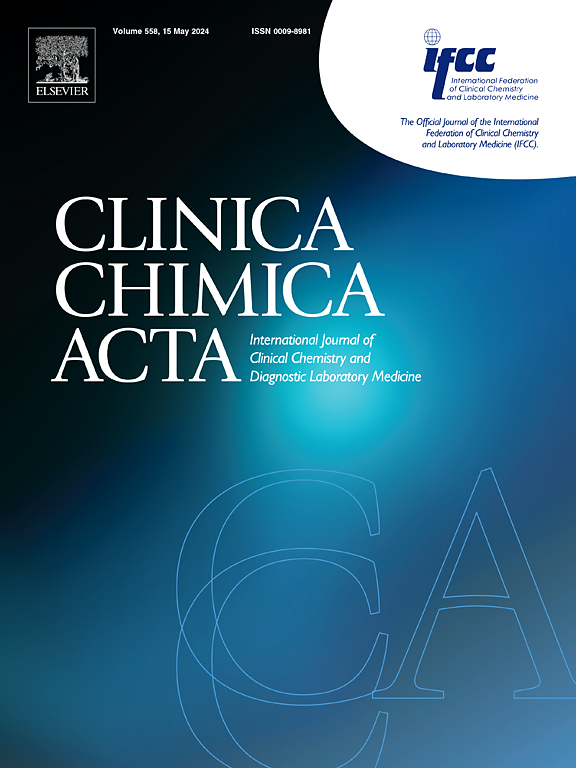Novel strategies in liquid biopsy
IF 2.9
3区 医学
Q2 MEDICAL LABORATORY TECHNOLOGY
引用次数: 0
Abstract
Cancer, a leading global cause of death, involves complex processes and multiple components. Due to the lack of effective and accurate early diagnostic methods, many patients are diagnosed with advanced cancer. Traditional tissue biopsy, while common, may increase the risk of metastasis. In contrast, liquid biopsy technology utilizes bodily fluids such as blood, urine, and saliva to analyze tumor-associated information, including circulating tumor DNA (ctDNA), circulating tumor cells (CTCs), exosomes, and various molecular markers. This technology has undergone rapid advancements, enabling its routine clinical use in cancer patients and broadening research horizons. ctDNA and CTCs can be isolated and analyzed from blood sample, providing valuable insights for therapeutic choices. However, technical and clinical challenges remain, such as the low proportion of ctDNA in circulating free DNA, the short half-life of ctDNA in blood, and the low concentration and heterogeneity of CTCs. Exosomes, abundant and stable vesicles released by most cells, carry bioactive molecules and play a pivotal role in intercellular communication, tumorigenesis, and progression. They offer advantages over CTCs and ctDNA but also present challenges in isolation, detection, and specificity. This review summarizes recent technologies for detecting ctDNA, CTCs, and exosomes in liquid biopsies, including nanotechnology, sensor technology, spectroscopy, microfluidic technology, and aptamers. It highlights their clinical applications and future development directions, elucidating their promising prospects in diagnosing cancer patients, monitoring disease progression, and predicting prognosis.
液体活检的新策略。
癌症是全球主要的死亡原因,涉及复杂的过程和多个组成部分。由于缺乏有效、准确的早期诊断方法,许多患者被诊断为晚期癌症。传统的组织活检虽然常见,但可能增加转移的风险。相比之下,液体活检技术利用体液,如血液、尿液和唾液来分析肿瘤相关信息,包括循环肿瘤DNA (ctDNA)、循环肿瘤细胞(CTCs)、外泌体和各种分子标记。这项技术发展迅速,使其能够在癌症患者中进行常规临床应用,拓宽了研究视野。ctDNA和CTCs可以从血液样本中分离和分析,为治疗选择提供有价值的见解。然而,技术和临床挑战仍然存在,例如循环游离DNA中ctDNA的比例低,血液中ctDNA的半衰期短,以及ctc的低浓度和异质性。外泌体是大多数细胞释放的丰富而稳定的囊泡,携带生物活性分子,在细胞间通讯、肿瘤发生和进展中起关键作用。与CTCs和ctDNA相比,它们具有优势,但在分离、检测和特异性方面也存在挑战。本文综述了液体活检中检测ctDNA、CTCs和外泌体的最新技术,包括纳米技术、传感器技术、光谱学、微流控技术和适配体。重点介绍了它们的临床应用和未来发展方向,阐述了它们在诊断癌症患者、监测疾病进展和预测预后方面的广阔前景。
本文章由计算机程序翻译,如有差异,请以英文原文为准。
求助全文
约1分钟内获得全文
求助全文
来源期刊

Clinica Chimica Acta
医学-医学实验技术
CiteScore
10.10
自引率
2.00%
发文量
1268
审稿时长
23 days
期刊介绍:
The Official Journal of the International Federation of Clinical Chemistry and Laboratory Medicine (IFCC)
Clinica Chimica Acta is a high-quality journal which publishes original Research Communications in the field of clinical chemistry and laboratory medicine, defined as the diagnostic application of chemistry, biochemistry, immunochemistry, biochemical aspects of hematology, toxicology, and molecular biology to the study of human disease in body fluids and cells.
The objective of the journal is to publish novel information leading to a better understanding of biological mechanisms of human diseases, their prevention, diagnosis, and patient management. Reports of an applied clinical character are also welcome. Papers concerned with normal metabolic processes or with constituents of normal cells or body fluids, such as reports of experimental or clinical studies in animals, are only considered when they are clearly and directly relevant to human disease. Evaluation of commercial products have a low priority for publication, unless they are novel or represent a technological breakthrough. Studies dealing with effects of drugs and natural products and studies dealing with the redox status in various diseases are not within the journal''s scope. Development and evaluation of novel analytical methodologies where applicable to diagnostic clinical chemistry and laboratory medicine, including point-of-care testing, and topics on laboratory management and informatics will also be considered. Studies focused on emerging diagnostic technologies and (big) data analysis procedures including digitalization, mobile Health, and artificial Intelligence applied to Laboratory Medicine are also of interest.
 求助内容:
求助内容: 应助结果提醒方式:
应助结果提醒方式:


